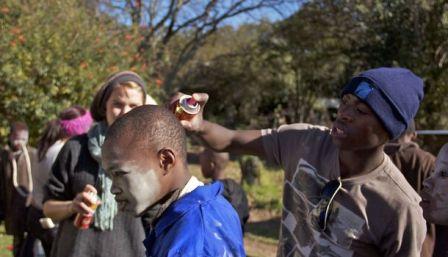
For the third year running volunteer students are collaborating with artists and performers with the aim of opening the festival up to everyone.
For the fourth day of the National Arts Festival, 25 youths from the Hlani district of Grahamstown’s eRhini township have trekked from their homes to the other side of the Settler City.
They’ve been shepherded by Kwanele September, age 17 who’s amongst the oldest in the group of boys – some of them as young as seven.
They arrive at Rhodes University’s campus at 9.30am to meet volunteer art students who are busy setting up the workshop for the day. They’d planned to decorate donkey carts today, but the donkey man was curiously absent. Instead, they decorate red capes which they’ll wear later in the day’s performances. These boys are affectionately known as buskers – street performers who entertain for a tip.
For the third year running volunteer students are collaborating with artists and performers from the Main and Fringe stages with the aim of opening the festival up to everyone. This is Art Factory, a community arts development programme that grew from the work of local Sakhuluntu Cultural Group. It aims to sharpen and provide new skills to the disadvantaged youth of Grahamstown, supporting their immediate need for earning, while cultivating a love for the arts.
But truth be told, without the initiative, the kids would still be up early footing it to the other side of town, vying for their slice of the festival pie.
Dressed in oversized suit jackets, their faces painted white, the boys were a staple sight of the festival pavements long before Art Factory tried to help formalise their presence.
Finding means of expression
Volunteers honour the enterprising spirits of the boys while seeking new ways of nurturing them. “We really allow them to make it their own, we want them to take initiative. It’s about them using all the cool things they can find so they can enhance their own performance,” says Bronwen Salton, who has worked with Art Factory since 2010.
Since her involvement, the group has done projects like creating plastic windsocks to string around town and decorating a “trash tree” - a freestanding sculpture made entirely of found materials. Last year they made puppets and overalls by ironing together plastic bags. The projects are adapted to the group’s needs and ideas.
“That’s how we roll, I take the stance of freedom of expression – it’s their choices, their life, their creativity,” says Salton.
Whatever the project, the initiative aims to strike a balance between empowering the boys to follow their own impulses and grounding them in necessary artistic and life-skills.
Art is only one side of the story. On a more basic level the boys are just struggling to survive. If they come to the workshop they’re sure to receive a hot meal for the day. So the feeding scheme is integral to the programme.
But there is an art to survival. Their backgrounds have taught the boys to be creative and resourceful.
“They solve a lot of problems we can’t. They’re so industrious, smart – so funny. They take on every task 150 percent – you just have to say do this and it’s done,” says Salton.
Apathy and complicity
Whatever the collaborators of Art Factory are doing it seems it’s working. This is the first year they didn’t need to recruit participants in the days leading up to the Festival. The core group of 15 boys were already meeting a week before to practice, says Kwanele September.
In a city as compact and as divided as Grahamstown, there’s no hiding the disparities.
But it’s a matter of really seeing them again. Confronting reality, our own apathy and complicity has been a major theme at this year’s festival – works like Mikhael Subotsky’s, Retinal Shift, Brett Bailey’s Exhibit A and provocative dance performance Southern Exposure, come to mind. But with initiatives like Art Factory, art and life are reflecting one another.
No doubt this intersection is a challenging place to be, but it’s not without its rewards: “I think this is the most happening place of the Festival – the most alive,” says Salton.
Story and picture by HAILEY GAUNT
Courtesy of Mail & Guardian
